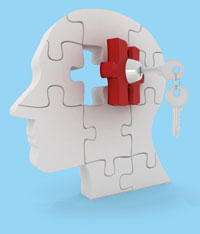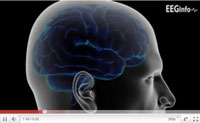Biofeedback and Neurofeedback Information
 Biofeedback, including brain-based biofeedback (Neurofeedback, Neurotherapy), HeartMath™, EmWave, and pIR™ biofeedback, teaches one to find inner peace and improve self regulation by providing moment by moment information about internal functions. As you learn about your own inner workings, we help you find ways to improve them.
Biofeedback, including brain-based biofeedback (Neurofeedback, Neurotherapy), HeartMath™, EmWave, and pIR™ biofeedback, teaches one to find inner peace and improve self regulation by providing moment by moment information about internal functions. As you learn about your own inner workings, we help you find ways to improve them.
How does biofeedback work?
The therapy is like a video game you play with your brain or your autonomic functions. You use your brain, the temperature of your fingers, your breath and your heart rate to control the action instead of a toggle stick. As you get information that you are changing the way you function, new patterns become habitual. Biofeedback is like learning to ride a bike. When you start to fall, you use your feedback to correct your balance. Soon you can balance without effort and ride joyously away.
 A simple… and fun process
A simple… and fun process
In Neurotherapy (brain-based or EEG biofeedback), tiny sensors are attached to your head with a paste. These sensors connect to a computer that measures brain wave activity with an electroencephalograph (EEG). The computer monitor displays a game which can only be played when you are calm and focused. Learn more about it on the “Faces of Neurofeedback” video.
Other forms of biofeedback, such as pIR, are very similar. In pIR, which specifically targets reduction of headaches, including migraines, a band placed over the forehead reads forehead temperature and blood flow. This information goes to the computer. When blood flow normalizes, the game can be played. With HeartMath, sensors measuring heart rate and salinity are attached to your fingers. As your body reaches homeostasis (center or calm), the game moves faster and becomes more enjoyable. HeartMathTM treatment, to help strengthen the heart-brain connection and handle stress and tension with ease, is also available.
Effective treatment for ADHD, ADD, PTSD and other disorders
 Biofeedback is considered an Effective Best Practice with good support for treatment of ADHD (read the State of Hawaii report, “Blue Menu-Evidence-Based Child and Adolescent Psychosocial Interventions” for more details.)
Biofeedback is considered an Effective Best Practice with good support for treatment of ADHD (read the State of Hawaii report, “Blue Menu-Evidence-Based Child and Adolescent Psychosocial Interventions” for more details.)
Research has proven Neurofeedback (also called Neurotherapy, EEG-, or brain-based biofeedback) and other forms of biofeedback effective in relieving symptoms of ADHD and ADD, anxiety and Post Traumatic Stress Disorder. It is helpful in the treatment of Depression, Bipolar Disorder, Addictions, and Reactive Attachment Disorder. Most migraine headache suffers experience a reduction in frequency and severity of headaches using a combination of Neurofeedback and other biofeedback techniques. Neurofeedback has been extensively researched; with many articles available.
Improve your life… for a lifetime
Biofeedback and Neurofeedback – Neurotherapy (EEG- or Brain Based biofeedback) are intensive interventions. Some improvement is expected after 10 sessions. A treatment to help a child focus well without medication for ADHD may last 40 to 50 sessions; however a treatment to decrease stress and improve executive functioning may be 10 or 12. The process is entirely natural – you train yourself to act differently, in a way that improves your life. Once you learn, you always have that ability, and never need further training.
What is biofeedback used for?
Students use it to improve focus and concentration. Neurofeedback (Neurotherapy) is especially helpful in calming those with hyperactivity. It’s used in private and charter schools throughout the country.
 Physicians recommend it as a non-medication alternative for treating migraines, headaches, and for reducing pain. The National Institute of Health and some medical insurance companies consider biofeedback the most effective intervention for headache relief. Click to watch a neurofeedback session or listen to a physician discuss it!
Physicians recommend it as a non-medication alternative for treating migraines, headaches, and for reducing pain. The National Institute of Health and some medical insurance companies consider biofeedback the most effective intervention for headache relief. Click to watch a neurofeedback session or listen to a physician discuss it!
Veterans use it to reduce the stress effects of deployment.
The Canadian Olympics team used it in 2010 to help improve their athletes’ focus and ability to stay in a winning zone. Canada won the gold for the first time. Read more about it in the “Training mind as well as body” article and in the “Olympic secrets revealed” article.
In Great Britain, the Royal Academy of Music uses it to improve performance of their students.
Golfers use it to improve their game.
Business executives use it to remain calm, focused and alert during stressful times.
Meditation practitioners use it to help improve their ability to meditate effectively.
Why biofeedback rather than medication?
According to U.S. News and World report, March 27, 2009, ADHD drugs don’t help children long term. “A study tracked children for eight years and found that those still taking stimulant medication fared no better in the reduction of symptoms such as inattention and hyperactivity or in social functioning than those who hadn’t.” And people who suffer from stress and anxiety have similar experiences. The convenient pill may help momentarily, but over the long term, stress and anxiety continue to be a problem. With biofeedback, you learn to stay calm and centered so problems don’t become so overwhelming.
Stop taking medication
“Students in the New Visions, Minnesota Charter School’s three year Research Neurofeedback Training Program … advanced far more rapidly than those not enrolled. Some hyperactive students … were able to stop taking medication and kindergarten and first-grade students were recognizing more words and beginning to read at faster rates.”
Star Tribune, 12/24/2002
Ritalin research shows…
“Stimulant drugs like Ritalin that are used to treat ADHD don’t improve children’s symptoms long term, according to new research published online in the Journal of the American Academy of Child and Adolescent Psychiatry.”
Nancy Schute, US News and World Report, March 27, 2009
